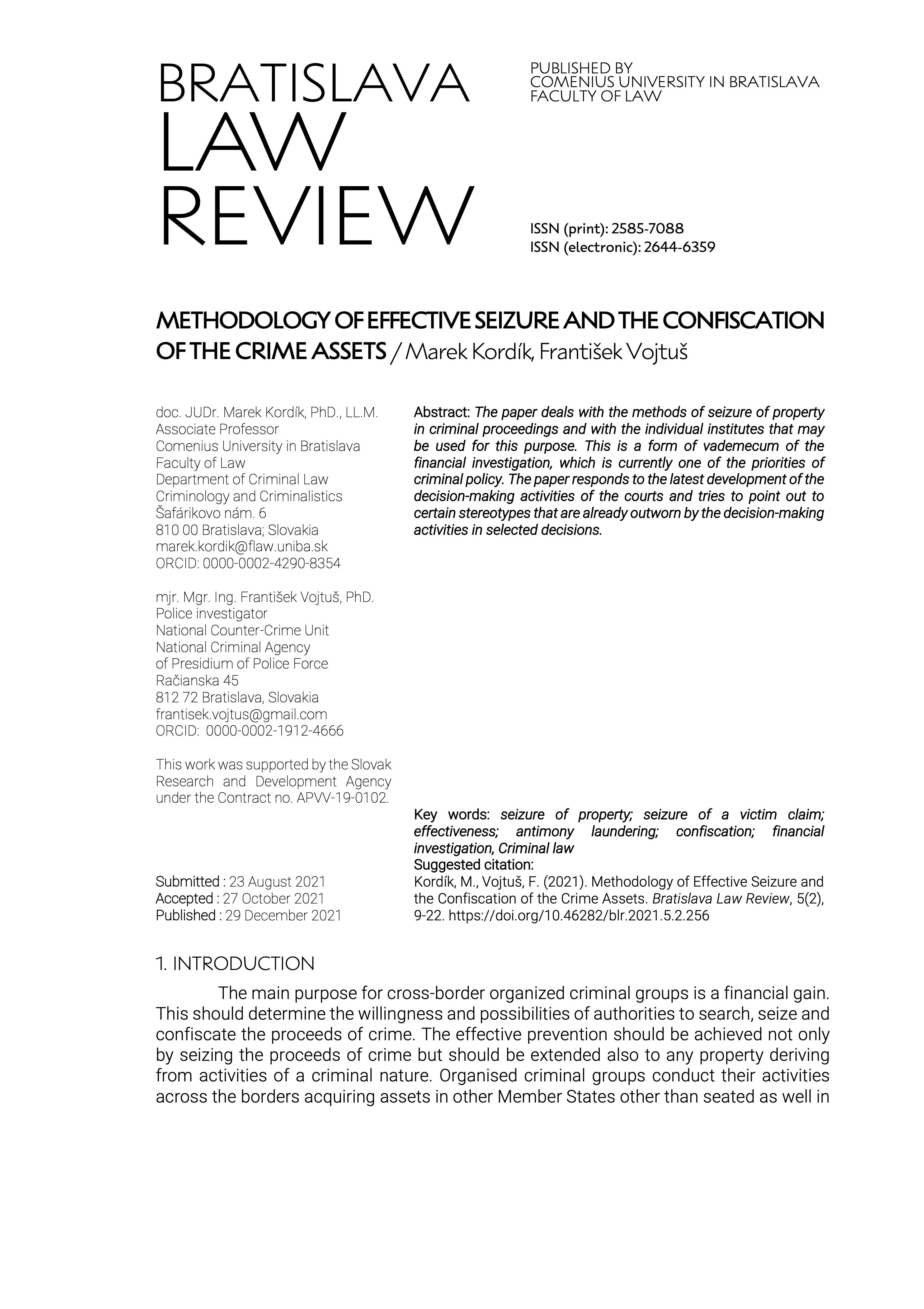Methodology of Effective Seizure and the Confiscation of the Crime Assets
DOI:
https://doi.org/10.46282/blr.2021.5.2.256Keywords:
seizure of property, seizure of a victim claim, effectiveness, antimony laundering, confiscation, financial investigationAbstract
The paper deals with the methods of seizure of property in criminal proceedings and with the individual institutes that may be used for this purpose. This is a form of vademecum of the financial investigation, which is currently one of the priorities of criminal policy. The paper responds to the latest development of the decision-making activities of the courts and tries to point out to certain stereotypes that are already outworn by the decision-making activities in selected decisions.
References
Banerjee, R. (n.d.). Factors that facilitated and sponsored the explosion of money laundering. Retrieved from http://people.exeter.ac.uk/watupman/undergrad/ron/explosion of money laundering.htm (accesed on: 27.10.2021).
Borlini, L. S., and Montanaro, F. (2017). The Evolution of the EU Law Against Criminal Finance: The ‘Hardening’ of FATF Standards within the EU. Georgetown Journal of International Law, 48, pp. 1009–1062. DOI: https://doi.org/10.2139/ssrn.3010099 DOI: https://doi.org/10.2139/ssrn.3010099
Čentéš, J., and Beleš, A. (2018). Regulation of agent as a tool for combating organized crime. Journal of Security and Sustainability Issues, 8(2), pp. 29–38. DOI: https://doi.org/10.9770/jssi.2018.8.2(3) DOI: https://doi.org/10.9770/jssi.2018.8.2(3)
Dion, M. (2015). Is money laundering an ethical issue? Journal of Money Laundering Control, 18(4), pp. 425–437. DOI: https://doi.org/10.1108/JMLC-06-2014-0018 DOI: https://doi.org/10.1108/JMLC-06-2014-0018
European Commission (2019). Report from the Commission to the European Parliament and the Council on the assessment of the risk of money laundering and terrorist financing affecting the internal market and relating to cross-border activities. Retrieved from: https://ec.europa.eu/info/sites/default/files/supranational_risk_assessment_of_the_money_laundering_and_terrorist_financing_risks_affecting_the_union.pdf (accesed on: 27.10.2021).
Muller, W. H., Kälin, C. H., and Goldsworth, J. G. (2007). Anti-Money Laundering: International Law and Practice. (W.H. Muller, C.H. Kälin, and J.G. Goldsworth,Eds.). Chichester: John Wiley & Sons.
Reuter, P., and Truman, E. M. (2004). Chasing dirty money: The fight against money laundering. Washington D.C.: Peterson Institute.
Richards, J. R. (1999). Transnational Criminal Organizations, Cyberrcrime, and Money Laundering: A Handbook for Law Enforcement Officers, Auditors and Financial Investigators. CRC Press. DOI: https://doi.org/10.1201/9781420048728
Šimonová, J., Čentéš, J., and Beleš, A. (2019). Financial analysis of innovative forms of money. Entrepreneurship and Sustainability Issues, 7(1), pp. 69–80. DOI: https://doi.org/10.9770/jesi.2019.7.1(6) DOI: https://doi.org/10.9770/jesi.2019.7.1(6)
Stessens, G. (2000). Money Laundering: A New International Law Enforcement Model. Cambridge: Cambridge University Press. DOI: https://doi.org/10.1017/CBO9780511494567
The Financial Action Task Force (2013a). FATF Guidance: National Money Laundering and Terrorist Financing Risk Assessment. Retrieved from https://www.fatf-gafi.org/media/fatf/content/images/National_ML_TF_Risk_Assessment.pdf (accesed on: 27.10.2021).
The Financial Action Task Force (2013b). Methodology for assessing technical compliance with the FATF recommendations and the effectiveness of AML/CFT systems. Retrieved from http://www.fatf-gafi.org/media/fatf/documents/methodology/FATF Methodology-March 2017-Final.pdf (accesed on: 27.10.2021).
The Financial Action Task Force (2016). Recommendations of FATF.
The Financial Action Task Force (2016a). Anti-money laundering and counter-terrorist financing measures in Isle of Man. Retrieved from https://rm.coe.int/anti-money-laundering-and-counter-terrorist-financing-measures-isle-of/168071610e (accesed on: 27.10.2021).
The Financial Action Task Force (2016b). Anti-money laundering and counter-terrorist financing measures in Italy. Retrieved from https://www.fatf-gafi.org/media/fatf/documents/reports/mer4/MER-Italy-2016-Executive-Summary.pdf (accesed on: 27.10.2021).
The Financial Action Task Force (2017). Anti-money laundering and counter-terrorist financing measures in Andorra. Retrieved from https://rm.coe.int/andorra-fifth-round-mutual-evaluation-report/168076613e (accesed on: 27.10.2021).
The Wolfsberg Group (2020). Developing an Effective AML/CTF Programme August 2020. Retrieved from https://www.wolfsberg-principles.com/sites/default/files/wb/Wolfsberg Effective Financial Crimes Programme - August2020 %28FFP%29.pdf (accesed on: 27.10.2021).
Charter of Fundamental rights of the European Union 2012/C 326/0.
Charter of Fundamental rights of the European Union 2012/C 326/02.
Czechoslovakia, Supreme Court of Czechoslovakia, Tz II 1/77 [R 31/1978] (24 March 1977).
Directive 2018/1673/EU of the European Parliament and of the Council of 23 October 2018 on combating money laundering by criminal law.
Directive 2014/42/EU of the European Parliament and of the Council of 3 April 2014, on the freezing and confiscation of instrumentalities and proceeds of crime in the European Union.
ECtHR, Zschüschen v. Belgium [dec.], app. no. 23572/07, 1 June 2017.
Germany, Federal Constitutional Court, M., 2 BvR 564/95 (14 January 2004).
Recital to the Directive 2014/42/EU of the European Parliament and the European Council of 3 April 2014 on the freezing and confiscation of instrumentalities and proceeds of crime in the European Union.
Slovakia, Constitutional Court of the Slovak Republic, III. ÚS 117/06 (23 August 2006).
United Kingdom, Zamira Hajiyeva v. National Crime Agency [2020] EWCA Civ 108.

Downloads
Published
License
Copyright (c) 2021 Bratislava Law Review

This work is licensed under a Creative Commons Attribution-NonCommercial-NoDerivatives 4.0 International License.
The Author(s) transfers copyright to the Article to the Publisher of the Journal by the Licence Agreement.
The Author(s) retains rights specified in the Licence Agreement.
The readers may read, download, copy, distribute, print, search, or link to the full texts of all of the Article of the Journal and use them for any other lawful purpose under specified Creative Commons Licence (CC BY-NC-ND 4.0).
How to Cite
Funding data
-
Agentúra na Podporu Výskumu a Vývoja
Grant numbers 19-0102











